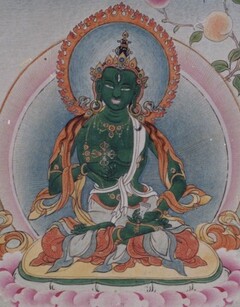Introduction to Vajravidāraṇa
Introduction to Vajravidāraṇa
by Stefan Mang
Vajravidāraṇa (Tib. rdo rje rnam par ’joms pa)—literally “Vajra Conqueror”—is a wrathful tantric deity invoked to purify karmic defilements, nullify black magic, dispel illness, and eliminate obstacles. Closely associated with Vajrapāṇi and often considered his emanation, Vajravidāraṇa plays a central role in tantric Buddhism as both a protector and a healer. His cult developed through a rich body of dhāraṇī (incantation) literature, sādhanas (practice manuals), and ablution rituals.[1]
The canonical source for Vajravidāraṇa is The Vajravidāraṇa Dhāraṇī, a short but powerful kriyā-tantra that introduces the deity in a dramatic narrative setting. In this text, Vajrapāṇi—empowered by the Buddha Śākyamuni—proclaims the dhāraṇī as a means to dispel disease, spirit harm, malevolent spells, and pervasive misfortune. The narrative centers on King Ajātaśatru, the ruler of Magadha who seized the throne by overthrowing his father, King Bimbisāra, and unleashing violence across the region. Wracked by inner torment and adversity, Ajātaśatru becomes the paradigmatic figure in need of purification, prompting Vajrapāṇi to reveal the dhāraṇī as a powerful ritual remedy.[2]
Building on this foundation, Vajravidāraṇa’s practice was elaborated in Indian and Tibetan commentarial traditions. In the eighth century, masters such as Guru Padmasambhava, Vimalamitra, and Buddhaguhya expanded the system through detailed maṇḍala visualizations, liturgical texts, and ritual prescriptions.
Over time, Vajravidāraṇa became a widely practiced figure across Tibetan Buddhist schools, integrated into treasure (gter ma) literature and included among the Ten Royal Sūtras, a group of texts believed to bring longevity and protection to the Tibetan King Tri Songdetsen.[3] In the Newar Buddhist context of Nepal, Vajravidāraṇa—appearing in female form as Vajravidāraṇā—became part of the Saptavāra liturgical cycle: seven powerful dhāraṇīs recited on successive days of the week for protection, purification, and merit.[4]
Today, Vajravidāraṇa remains an active figure in Buddhist ritual life. He is invoked through mantra recitation, ritual ablutions, and tantric meditation to conquer obscurations and purify the body and mind. Whether in monastic ceremonies, healing rites, or daily practice, Vajravidāraṇa endures as a potent symbol of purification and transformation.
Further Reading
Bühnemann, Gudrun. “A Dhāraṇī for Each Day of the Week: The Saptavāra Tradition of the Newar Buddhists.” Bulletin of the School of Oriental and African Studies 77, no. 1 (2014): 119–36.
Schmidt, Nicholas. “The Jewel’s Radiance: A Translation of ‘Ratnabhāsvara,’ an Extensive Commentary on the Vajravidāraṇa-nāma-dhāraṇī.” Master's thesis. Kathmandu University, 2018.
Version: 1.0-20250711
